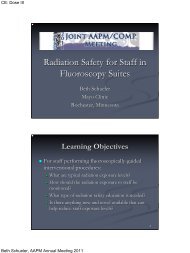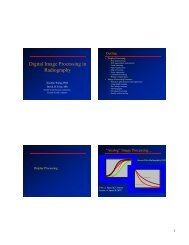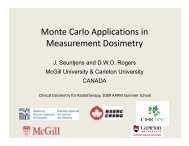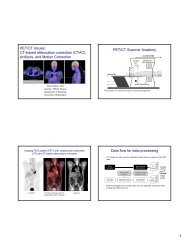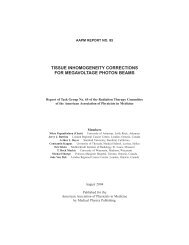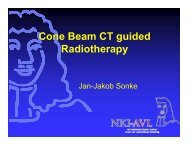Practical Medical Physics: Head and Neck Contouring
Practical Medical Physics: Head and Neck Contouring
Practical Medical Physics: Head and Neck Contouring
Create successful ePaper yourself
Turn your PDF publications into a flip-book with our unique Google optimized e-Paper software.
<strong>Practical</strong> <strong>Medical</strong> <strong>Physics</strong>:<br />
<strong>Head</strong> <strong>and</strong> <strong>Neck</strong> <strong>Contouring</strong><br />
AAPM 2011<br />
Vancouver, British Columbia<br />
Jonn Wu, BMSc MD FRCPC<br />
Radiation Oncologist, Vancouver Cancer Centre, BCCA<br />
Clinical Assistant Professor, UBC<br />
August 2 nd , 2011
Objectives<br />
Review Selection of Normal Organs<br />
• Brachial Plexus<br />
• Pharyngeal Constrictors<br />
• Salivary Gl<strong>and</strong>s<br />
• Parotid<br />
• Subm<strong>and</strong>ibular<br />
Target Audience:<br />
• Physicists<br />
• Dosimetrists<br />
• Radiation Therapists
Outline<br />
Why do we have to Contour?<br />
Which Organs are Important?<br />
How *I* contour?<br />
3 Important Organ Systems<br />
• Xerostomia: Salivary Gl<strong>and</strong>s<br />
• Parotid<br />
• Subm<strong>and</strong>ibular<br />
• Dysphagia: Pharyngeal Constrictors<br />
• Brachial Plexus
Outline (cont)<br />
For Each Organ System<br />
• Anatomy<br />
• Literature<br />
• Examples
Why do we have to contour?<br />
• Target delineation<br />
• Organ avoidance<br />
2D → 3D → IMRT<br />
(your fault)
2D Planning
2D Planning
2.5D…
3DCRT
IMRT
IMRT & Contours<br />
• Inverse Planning<br />
• Objective Cost Function<br />
• Computers are Binary
Why take a contouring course?<br />
• IMRT <strong>and</strong> 3D = st<strong>and</strong>ard practice<br />
• Both techniques require (accurate) contours<br />
• Clinical trials require dose constraints<br />
• Consistency (precision)<br />
• Who:<br />
• Intra- vs inter-contourer<br />
• Intra- vs inter-institutional<br />
• Why:<br />
• Good practice<br />
• Dose constraints<br />
• Dosimetric repositories
Why take a contouring course?<br />
• No formal training<br />
• Few reproducible guidelines<br />
• Everyone assumes consistent contouring<br />
• NCIC HN6, RTOG 0920, 0615, 0225<br />
• Spinal Cord:<br />
• Intra-observer: avg 0.1 cm, max 0.7 cm<br />
• Inter-observer: avg 0.2 cm, max 0.9 cm<br />
Geets RO 2005
Which organs are important<br />
Brain (temporal lobe)<br />
Globe, retina<br />
Lens<br />
Optic nerve, optic chiasm<br />
Pituitary gl<strong>and</strong><br />
Brainstem, spinal cord<br />
Inner ear<br />
TMJ<br />
M<strong>and</strong>ible<br />
Larynx<br />
Esophagus<br />
Oral cavity<br />
Thyroid<br />
Vasculature<br />
Xerostomia - Salivary Gl<strong>and</strong>s<br />
Dysphagia - Pharyngeal Constrictors<br />
Brachial plexus
For Each Organ System<br />
• Anatomy<br />
• Literature<br />
• Examples<br />
(No Time For)<br />
• Targets (GTV)<br />
• ICRU (xTVs, PRV)<br />
• Contour editing (surface cropping, overlapping)<br />
• Autosegmentation<br />
• Imaging modalities<br />
• Intra-treatment changes<br />
• Dose volume constraints
How *I* Contour<br />
• St<strong>and</strong>ard CT technique<br />
• 2.5mm slices, 2.5mm spacing<br />
• Matrix size 512 x 512<br />
• IV Contrast<br />
• HU Settings<br />
• Window 400, Level 50<br />
• Maximize visual real estate<br />
• Scrolling<br />
• Software tools: above/below<br />
• Tablet/Pen<br />
• Consultation: RO, DI<br />
Holistic <strong>Contouring</strong><br />
Digital & Physical Optimization
Xerostomia: Salivary Gl<strong>and</strong>s<br />
• Anatomy<br />
• Literature<br />
• Examples
Salivary Gl<strong>and</strong>s: Anatomy<br />
• Major Salivary Gl<strong>and</strong>s<br />
1. Parotid<br />
2. Subm<strong>and</strong>ibular<br />
3. Sublingual<br />
• Secrete saliva<br />
• Speech, taste, swallowing<br />
• Digestive enzymes<br />
• Prevent inflammation <strong>and</strong> dental caries<br />
• Saliva<br />
• 0.5 L secreted per day<br />
• Resting: 0.3 mL/min<br />
• Parotid = 20%<br />
• Subm<strong>and</strong>ibular = 65%<br />
• Sublingual, Minor = 15%<br />
• Stimulated: 1.5–2 mL/min<br />
• Parotid = 50%
Salivary Gl<strong>and</strong>s: Parotid<br />
• paired, 25-30 g, accessory gl<strong>and</strong>: 20%<br />
• borders:<br />
• superior: zygomatic arch<br />
• inferior: hyoid bone<br />
• anterior: anterior ramus m<strong>and</strong>ibular arch<br />
• posterior: mastoid process<br />
• medial: carotid sheath or masseter muscle<br />
• lateral: skin<br />
• Structures within Parotid<br />
• External carotid artery, Retrom<strong>and</strong>ibular vein<br />
• Facial nerve<br />
• Parotid Duct:<br />
• 5 cm long, 3 mm wide<br />
• Crosses masseter, right angle, buccal fat pad/buccinator, runs obliquely<br />
forwards, opens @ second upper molar
Salivary Gl<strong>and</strong>s: Subm<strong>and</strong>ibular<br />
• 10-20 g, size of walnut<br />
• Borders:<br />
• Superior: medial surface of m<strong>and</strong>ible, lingual N<br />
• Inferior: soft tissues of neck, hypoglossal N<br />
• Medial/Anterior: floor of mouth (mylohyoid, hypoglossus mm)<br />
• Posterior: subm<strong>and</strong>ibular LN, carotid sheath<br />
• Lateral: skin
Salivary Gl<strong>and</strong>s: Literature<br />
Van de Water et al, RO, 2009
Parotid Gl<strong>and</strong>s: Examples<br />
• superior: zygomatic arch<br />
• inferior: hyoid bone<br />
• anterior: anterior ramus m<strong>and</strong>ibular arch<br />
• posterior: mastoid process<br />
• medial: carotid sheath or masseter muscle<br />
• lateral: skin
Parotid Gl<strong>and</strong>s: Examples
Parotid Gl<strong>and</strong>s: Use your tools.
Parotid Gl<strong>and</strong>s: Examples
Parotid Gl<strong>and</strong>s: Examples
Subm<strong>and</strong>ibular Gl<strong>and</strong>s<br />
• Superior: medial surface of m<strong>and</strong>ible, lingual N<br />
• Inferior: soft tissues of neck, hypoglossal N<br />
• Medial/Anterior: floor of mouth (mylohyoid, hypoglossus mm)<br />
• Posterior: subm<strong>and</strong>ibular LN, carotid sheath<br />
• Lateral: skin
Subm<strong>and</strong>iblar Gl<strong>and</strong>s: Examples
Subm<strong>and</strong>ibular Gl<strong>and</strong>s: Inferior
Salivary Gl<strong>and</strong>s: Summary<br />
• Parotid most variable<br />
• Know potential limits<br />
• Scroll<br />
• Sup/Inf tool
Dysphagia: Pharyngeal constrictors<br />
• Anatomy<br />
• Literature<br />
• Examples
Pharyngeal Constrictors: Anatomy<br />
• Programmed motor behaviour<br />
• seconds<br />
• Stimulation of sensory nerves in the oropharynx<br />
• 600 <strong>and</strong> 1000 times in 24 hours<br />
• Eating <strong>and</strong> drinking are basic human pleasures<br />
• significant impact upon the quality of life<br />
• Four phases:<br />
• Oral preparatory<br />
• Oral transit<br />
• Pharyngeal<br />
• Esophageal
Pharyngeal Constrictors: Anatomy<br />
• longitudinal muscles: stylopharyngeus, salpingopharyngeus, palatopharyngeus<br />
• circular constrictors: superior, middle, <strong>and</strong> inferior<br />
• epiglottis, larynx<br />
• posterior surface of base of tongue<br />
• suprahyoid muscles (geniohyoid, mylhyoid, digastric)
Pharyngeal Constrictors: Anatomy
Pharyngeal Constrictors: Anatomy, Literature<br />
DARS: dysphagia aspiration related structures<br />
CT:<br />
• Constrictors: median medial thickness – 2.5 mm to 7 mm<br />
• Larynx (supraglottic + glottic): 2 mm to 4 mm<br />
** Primary Structures:<br />
1. Pharyngeal Constrictors<br />
2. Larynx<br />
Eisbruch IJROBP, 2004
Pharyngeal Constrictors: Eisbruch<br />
Pharyngeal constrictors<br />
• lateral <strong>and</strong> posterior pharyngeal<br />
walls<br />
• superior: to pterygoid plates<br />
• middle: to hyoid bone<br />
• inferior: to thyroid cartilage<br />
• contoured as single organ<br />
Supraglottic <strong>and</strong> glottic larynx<br />
• contoured as single organ
Pharyngeal Constrictors: Superior <strong>Neck</strong>
Pharyngeal Constrictors: Hyoid Bone
Pharyngeal Constrictors: Thyroid Cartilage
Pharyngeal Constrictors<br />
• Larynx<br />
• Oral Cavity<br />
• PTV overlap
Pharyngeal Constrictors: Unilateral PTV
Pharyngeal Constrictors: Bilateral PTV
Pharyngeal Constrictors: Summary<br />
• Clinically important<br />
• Difficult to spare, depending on adjacent targets<br />
• Ipsilateral vs bilateral RT<br />
• Adjacent structures:<br />
• Larynx<br />
• Oral Cavity<br />
• Consider combination:<br />
• Laryngopharynx<br />
• Oral Cavity/Pharynx
Brachial Plexus<br />
• Anatomy<br />
• Literature<br />
• Examples
Brachial Plexus: Anatomy<br />
• Cutaneous <strong>and</strong> muscular innervation “most” of upper limb<br />
• Two exceptions:<br />
• trapezius muscle (spinal accessory nerve [CN XI])<br />
• area of skin near axilla (intercostobrachial nerve)<br />
• The five roots merge to form three trunks:<br />
• Super: C5, C6<br />
• Middle: C7<br />
• Inferior: C8, T1<br />
Hard To See!
Brachial Plexus: 5 Roots 3 Trunks<br />
** Note **<br />
• Seven cervical vertebrae (C1-C7)<br />
• Eight cervical nerves (C1-C8)<br />
• C1-C7: emerge above Cx<br />
• C8: emerges below C7<br />
• T1 etc emerge below T1
Brachial Plexus: L<strong>and</strong>marks<br />
C5, T2
Brachial Plexus: L<strong>and</strong>marks<br />
Brachial Plexus travels<br />
between:<br />
• Scalenus Anterior<br />
• Scalenus Medius<br />
Dr. Monty Martin, BCCA (Chief, Neuroradiology)
Brachial Plexus: Ant/Med Scalenus<br />
Anterior Scalenus:<br />
• aka scalenus anterior, scalenus anticus<br />
• transverse processes of C3-C6 to first rib<br />
• anterior to medial scalenus<br />
Medial Scalenus:<br />
• largest <strong>and</strong> longest of the three scalene muscles<br />
• posterior tubercles of transverse processes C2-C7<br />
to first rib
Brachial Plexus: Axilla<br />
• Behind Axillary Artery<br />
Posterior<br />
Anterior
Brachial Plexus: L<strong>and</strong>marks<br />
• C5<br />
• T1 or T2<br />
• Anterior scalenus<br />
• Medial scalenus<br />
Axilla:<br />
• Axillary artery
Brachial Plexus: Literature<br />
Hall et al, IJROBP, 2008
Brachial Plexus: Examples – C5
Brachial Plexus: Examples – T1
Brachial Plexus: Scalenus mm<br />
Brachial plexus<br />
Scalenus Anterior<br />
Scalenus Medius
Brachial Plexus: Scalenus mm<br />
Brachial plexus<br />
Scalenus Anterior<br />
Scalenus Medius
Brachial Plexus: Scalenus mm<br />
Brachial plexus<br />
Scalenus Anterior<br />
Scalenus Medius
Brachial Plexus: Scalenus mm<br />
Brachial plexus<br />
Scalenus Anterior<br />
Axillary A.
Brachial Plexus: Scalenus mm<br />
Brachial plexus<br />
Axillary V.<br />
Axillary A.<br />
B.P.
Brachial Plexus: Scalenus mm<br />
Brachial plexus<br />
Axillary V.<br />
Axillary A.<br />
B.P.
Brachial Plexus: Examples – Foramina
Brachial Plexus: Examples – Non-Foramina
Brachial Plexus: Full Structure
Brachial Plexus: Examples
Brachial Plexus: Axilla
Brachial Plexus: Comments<br />
• Brachial Plexopathy = rare<br />
• Adjacent GTV/LN<br />
• Not contoured off-study @ BCCA<br />
• Reproducible contours possible<br />
• Axilla?<br />
• Further research<br />
• Dosimetric Repository
H&N <strong>Contouring</strong>: Summary<br />
• Parotid Gl<strong>and</strong>: variable in shape<br />
• Subm<strong>and</strong>ibular Gl<strong>and</strong>: superior end<br />
• Pharyngeal Constrictors: Consider -<br />
• Laryngopharynx<br />
• Oral Cavity/pharynx<br />
• Brachial Plexus: requires further study<br />
• General technique:<br />
• Scroll<br />
• Superior/Inferior tool<br />
• Window level, maximize screen real estate<br />
• Tablet/Pen<br />
• Consultation: RO, DI
Acknowledgements<br />
Dr. John Hay (Radiation Oncologist)<br />
Drs. M. Martin, C. Mar, Y. Arzoumanian (Radiologists)<br />
jonnwu@bccancer.bc.ca




